Realizing Our Public Service Through Continuous Community Engagement – Recounting Spring and Summer 2023
Realizing Our Public Service Through Continuous Community Engagement – Recounting Spring and Summer 2023
When’s the last time you thought about what being a public servant really means for us at the U.S. Census Bureau? This question transcends our specific roles and contributions associated with our job titles. As I’ve often said, every person at the Census Bureau contributes critically to our mission, period. Without our single enterprise, community-of-the-whole effort, we would not be effective. We all must do our parts toward the common good.
Consider our mission as the leading provider of quality data on our nation’s people, places and economy. For whom do we provide our statistical data? Yes, we have many historical data user constituencies – federal, state and local government, the business sector, policy researchers, advocacy groups, scholars, students, to name a few.
But I like to think that our data are literally for every person residing in our nation. And if we are true public servants, then we’re obliged to offer our statistical data products in a way that is consumable to the public, to everyone. This includes but transcends our historical data constituencies to embrace all who do not yet know about or appreciate the exquisite value and potential of our statistical data.
One critically important way we do that is through continuous engagement with communities across America to hear about their local data needs.
Toward that end, I – accompanied by many of my Census Bureau colleagues – have participated in many engagement activities across our great nation. In April, I shared some of my travels and engagements from the beginning of this year. But we never stopped! So, here’s a quick update on what’s been happening since my last report.
In April, May, June and July, we expanded our outreach to include meeting with communities, partners, data users and the media in eight states (California, Louisiana, Maryland, Michigan, New York, North Carolina, Pennsylvania and Texas) as well as in the District of Columbia. Many of these locations include areas and populations that have been historically undercounted.
By leveraging existing trusted ecosystems, we conducted meaningful, specific conversations with advocacy and community-based organizations, chambers of commerce, government colleagues, tribal leaders, businesses and academics. I appreciate their willingness to engage in a two-way flow of ideas, share suggestions and voice concerns. We have shared their input with Census Bureau staff and program areas tasked to address them.
Here are some highlights:
- I spoke to students and graduates at North Carolina State University and San Antonio College. As they began their post-graduate lives, I reminded them of the value of bringing their own diverse perspectives to their work and encouraged them to do so. I’m so proud that the Census Bureau is supporting opportunities for new graduates to pursue careers in data science; they can support and grow census data programs that describe and serve richly diverse communities. Yes, it was a tremendous honor to receive honorary degrees from both institutions: a doctorate of science from NCSU and an associate degree from SAC. But it was more important to communicate our eagerness to hear and include their diverse perspectives. All who listened were invited to be a part of our Census Bureau team. And we welcomed any thought, suggestion or concern they have to offer.
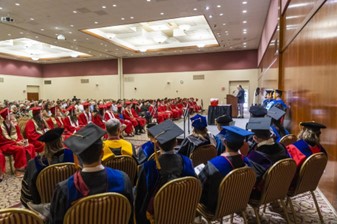
Addressing graduates of North Carolina State University’s School of Statistics
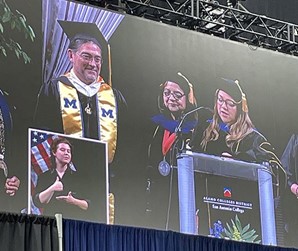
Receiving an honorary associate degree from San Antonio College
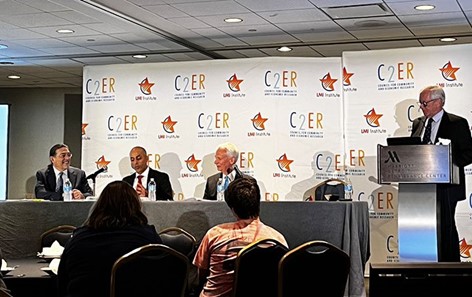
Participating on a panel with Vipin Arora, Director of the U.S. Bureau of Economic Analysis, and Bill Wiatrowski, Acting Director of the U.S. Bureau of Labor Statistics, at the Council for Community and Economic Research Conference.
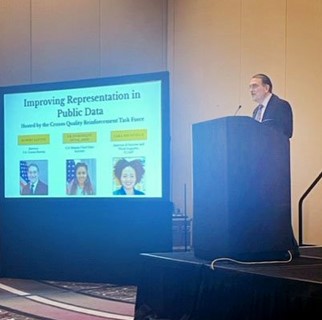
Speaking at the Population Association of America conference on improving representation in public data
- I spoke with researchers, academics and data users at meetings of the Population Association of America, the American Association for Public Opinion Research, the Council for Community and Economic Research, the Texas Demographic Conference and the AUDIENCExSCIENCE Conference. I shared how the Census Bureau listens, tests, learns and innovates through more than 130 demographic and economic surveys every year to better understand America’s people, places and economy.
- Closer to home, I participated in the American Community Survey (ACS) Data Users Conference. As I said in my confirmation hearing, the ACS is a national treasure! The ACS is the largest household survey conducted by the Census Bureau, and its results are widely used. ACS data help allocate trillions of dollars in federal funding every year. Governments, businesses, researchers and communities rely on the ACS for community planning and local decision-making. Studied over time, ACS results reveal changes in the size, composition and needs of communities, large and small. The exchange of ideas in community conversations informs how we might collect and disseminate quality data about all of America’s communities in the future.
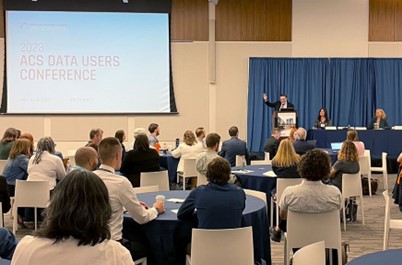
Addressing the 2023 American Community Survey Data Users Conference
- I participated in the Indian Country Data Working Group that our colleagues at the U.S. Department of the Interior put together. With tribal representatives, we discussed potential improvements in data on American Indian and Alaska Natives with regard to geographic boundaries and data dissemination. Collaborations like these focus on producing more timely, useful statistics to increase their value to the people of Indian Country.
- While the Census Bureau was conducting its quinquennial economic census, I took additional opportunities to talk about the Census Bureau’s wealth of economic data and the 2022 Economic Census. I met with business leaders across the nation, including the Philadelphia Chinatown Development Corporation, the Greater Philadelphia Hispanic Chamber of Commerce and the Detroit chapter of the National Business League. We are in the final stages of encouraging businesses to respond to the 2022 Economic Census. Because it is our first post-COVID census of the entire economy, I vigorously promoted the importance of responding to chambers of commerce and in local and national media interviews. Please encourage businesses in your community to keep responding!
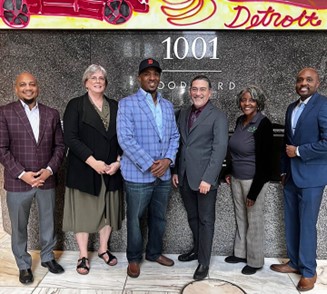
Meeting with representatives from the Detroit chapter of the National Business League
- In Houston, I spoke to journalists from well over a dozen ethnic media outlets about the wealth and breadth of statistics we produce, our resources for journalists and our upcoming data releases on race and ethnicity (more about that below).
- Along with Deputy Director Ron Jarmin, I spoke from the heart to Bowie State University students at their Second Annual Data Science and Analytics Symposium. Last year, the Census Bureau signed a memorandum of understanding with Bowie State to encourage students to pursue careers in data science. We enjoyed hearing about students’ research projects. They analyzed federal datasets to propose solutions that would address disparities in economics, education and health. Partnerships with universities and colleges like Bowie State and the University of Texas at San Antonio will help ensure future leaders in our increasingly data-driven world are more agile, resourceful, critical thinkers. Such people are more likely to find value in and leverage the Census Bureau’s data portfolio and keep us at the forefront of new scientific developments.
- We met with the Funders’ Committee for Civic Participation to discuss the Census Bureau’s transformation and modernization efforts. We’re moving from a legacy approach of public solicitation, where we ask people and businesses for information. Under our new vision, we’re flipping that model on its head – we’re embracing a single-enterprise operation that uses common platforms to capture, process and deliver new data products that our nation’s communities need.
- A contingent from the Census Bureau and I attended the Joint Statistical Meetings in Toronto to tell attendees about our datasets and tools, and I spoke about my approach to leading the largest federal statistical agency in our nation.
- Members of our Census Bureau community are a critical component of a “community-of-the-whole” approach. My second visits to our regional offices in New York and Philadelphia were very informative. I appreciate our staff taking the time to discuss their work and the challenges they face. One of my favorite activities on these visits is accompanying a Census Bureau field representative as they solicit participation in our surveys. In this day-in-the-life of a field rep opportunity, I observed how we collect data for the New York Housing and Vacancy Survey.
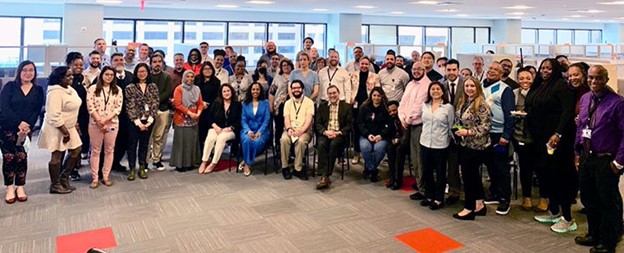
Meeting with Census Bureau employees at the New York regional office
In my interactions with the public, one message that I hear over and over is the value of disaggregated data, especially by race and ethnicity. To better understand the increasing complexities of our communities, it’s clear we need data that better reflect our nation’s demographic characteristics. This summer, the Census Bureau began releasing a series of valuable new datasets on race and ethnicity.
Data releases such as the Demographic and Housing Characteristics File (DHC) and Demographic Profile, the ACS Selected Population and American Indian and Alaska Native Tables, and the Population Estimates Demographic Release are important to community groups, elected officials, businesses, educators and many others. The richness of these detailed population characteristics brings valuable new insights on the populations of their states, counties, cities and towns.
I want to thank the many communities and partners who let us know just how important these data are to them. I especially want to thank everyone who provided us with feedback on our demonstration data products. Your feedback was invaluable. It allowed us to make the necessary improvements to the confidentiality protection mechanisms, while preserving quality statistics with high utility. We will continue to prioritize the development of data tools and products tailored to better serve different user communities.
Also, I offer a big thank you to the public for your responses to Census Bureau censuses and surveys. Your participation is what makes these valuable statistics possible!
Thanks for following along on my journey. These conversations are critical to understanding the needs of our data users and inform our decision making. Only by continuing to engage with partners, data users, communities, tribes, government and the public will we be able to stay true to our mission: to produce quality data on our nation’s people, places and economy.



